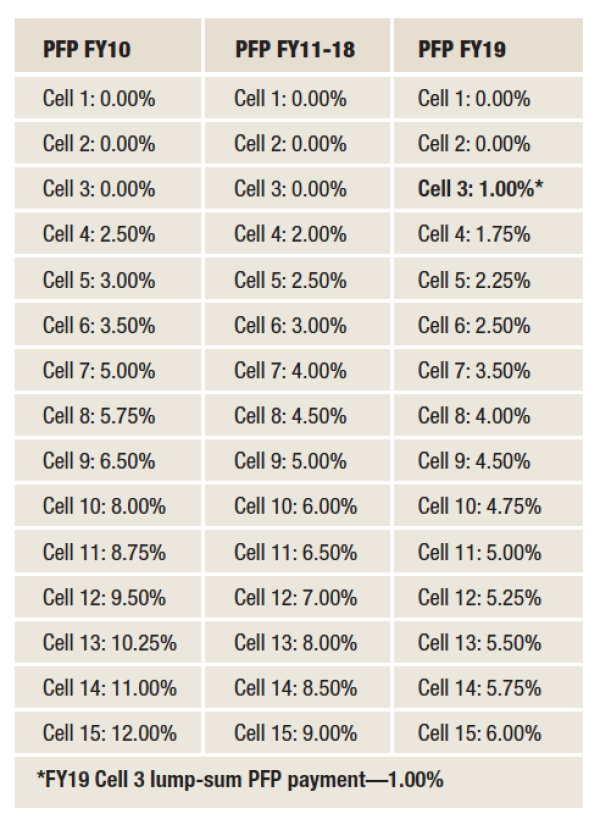Robbing EAS to Pay EAS
Robbing EAS to Pay EAS
By Brian J. Wagner
NAPS President
After a very long pay consultation and fact-finding process, NAPS received the Postal Service’s final FY16-19 EAS field pay decision on May 15. Although the Federal Mediation and Conciliation Service-commissioned factfinding panel found in its report that the USPS Pay-for-Performance (PFP) system is “seriously flawed”—the panel’s characterization, not mine—the Postal Service elected not to commit to reforming PFP in any meaningful way. Unfortunately, its decision to keep the same PFP system in place will sacrifice future EAS salaries and pensions. Here’s the scoop!
A review of PFP payouts over the past decade reveals a significant downward trend in PFP rewards to EAS employees. When you examine the Postal Service’s PFP history from FY10 to FY19, a decline in PFP payouts is clearly evident. The chart below compares FY10, FY11-18 and new FY19 PFP percentage payouts; it clearly shows the downward trend.

The reductions in FY11-15 ranged from .5% to 3%lower in PFP cells 4-15. Thus, EAS employees who achieved higher performance by their placement in the higher-performance cells ultimately received less pay than before under the FY11-15 pay package.
As members will recall, EAS salaries were frozen in FY11 and FY12. We received only a 1% pay increase for FY13. In providing payouts in FY19 under the FY16-19 EAS pay decision, the Postal Service once again lowered the payouts, compared to FY18 payout levels.
During the USPS-NAPS pay consultation process leading up to the FY16-19 EAS pay decision, the Postal Service initially insisted on a zero pay increase in cells 2 and 3. NAPS urged the USPS to provide PFP payouts in cells 2 and 3 that were greater than zero. Alternatively, NAPS urged the Postal Service to provide lumpsum payments in cells 2 and 3 and retain PFP payouts in cells 4-15 at FY18 levels. NAPS also maintained that the entire PFP system was broken and required an overhaul—a position the fact-finding panel confirmed.
In its initial June 28, 2018, pay decision, the USPS elected to use a 10-cell PFP matrix with lumpsum and base salary increases in cells 2 through 10 for FY19. Once again, reductions in PFP payouts dominated the Postal Service’s approach. Base salary increases were considerably lower for FY19 than those a year earlier in FY18.
When the Postal Service ultimately issued its modified pay decision for the FY16-19 period on July 20, 2018, the Postal Service reverted to a 15-cell PFP matrix for FY19 and eliminated all lumpsum payouts except for a 1% payout in cell 3. But cell 2 was back to zero with no payout. To add insult to injury, FY19’s base salary increases for cells 4-15 were reduced from FY18 PFP payout levels.
For example, the FY19 PFP base salary increase in cell 4 was down to 1.75%, which represented a .25 % reduction from the 2% payout in cell 4 a year earlier. It does not take a PhD in economics or a CPA to understand that lowering the FY19 PFP base salary increases in cells 4-15 from FY18 levels will result in slower growth in EAS salaries and reduced value in FERS pensions.
Furthermore, the Postal Service’s FY19 pay decision provided only a 1% lumpsum payment in cell 3, instead of a 1% increase in salary, as urged by NAPS. As a result, as of this writing, over 10,000 EAS employees who occupy cell 3 will receive no increase in their base salary for FY19—only a lumpsum payment.
Besides the 10,000 in cell 3, there are approximately 3,000 EAS employees currently in cells 1 and 2 who will receive no base salary increase or PFP lumpsum payment for all their hard work throughout the USPS fiscal year. So long as EAS employees continue to receive only annual lumpsum payouts without increases in their base salaries or no PFP payout at all, the value of their FERS pensions will trend lower.
Looking ahead, if reduced PFP payout percentages in cells 4-15 remain the same, the USPS will reap further savings on the backs of the EAS workforce. Broadly speaking, reduced levels of PFP funding have lowered PFP payouts over the course of the past decade. Even with the Postal Service providing lumpsum payments to cell 3 occupants, these payments are being offset by reduced PFP payouts in the higher cells. This zero-sum approach toward FY19 PFP payouts could be called the “Robbing EAS to Pay EAS” pay program.
Experts tell us that well-designed pay-for-performance programs focused on changing employee behavior produce higher levels of workplace engagement and productivity, bringing positive results to the organization’s bottom line. More active engagement, the thinking goes, merits higher compensation paid by the organization to its employees—not from its employees.
Unfortunately, the Postal Service has rejected that kind of thinking, along with most of the fact-finding panel’s recommendations. The Postal Service has chosen to continue to embrace a seriously flawed (again, the panel’s words—not mine) pay-for-performance program that badly is in need of an overhaul.
It is not only disappointing, but very maddening to those who also recognize the truth about the flaws with PFP. The Postal Service’s actions bring to mind Albert Einstein’s definition of insanity: doing something over and over again and expecting a different result. Inevitably, that kind of thinking must end.
I think it’s time to end this article with my September ice-cream-flavor-of-the-month recommendation: midnight chocolate madness.
